2016 TOYOTA SIENNA flat tire
[x] Cancel search: flat tirePage 6 of 668
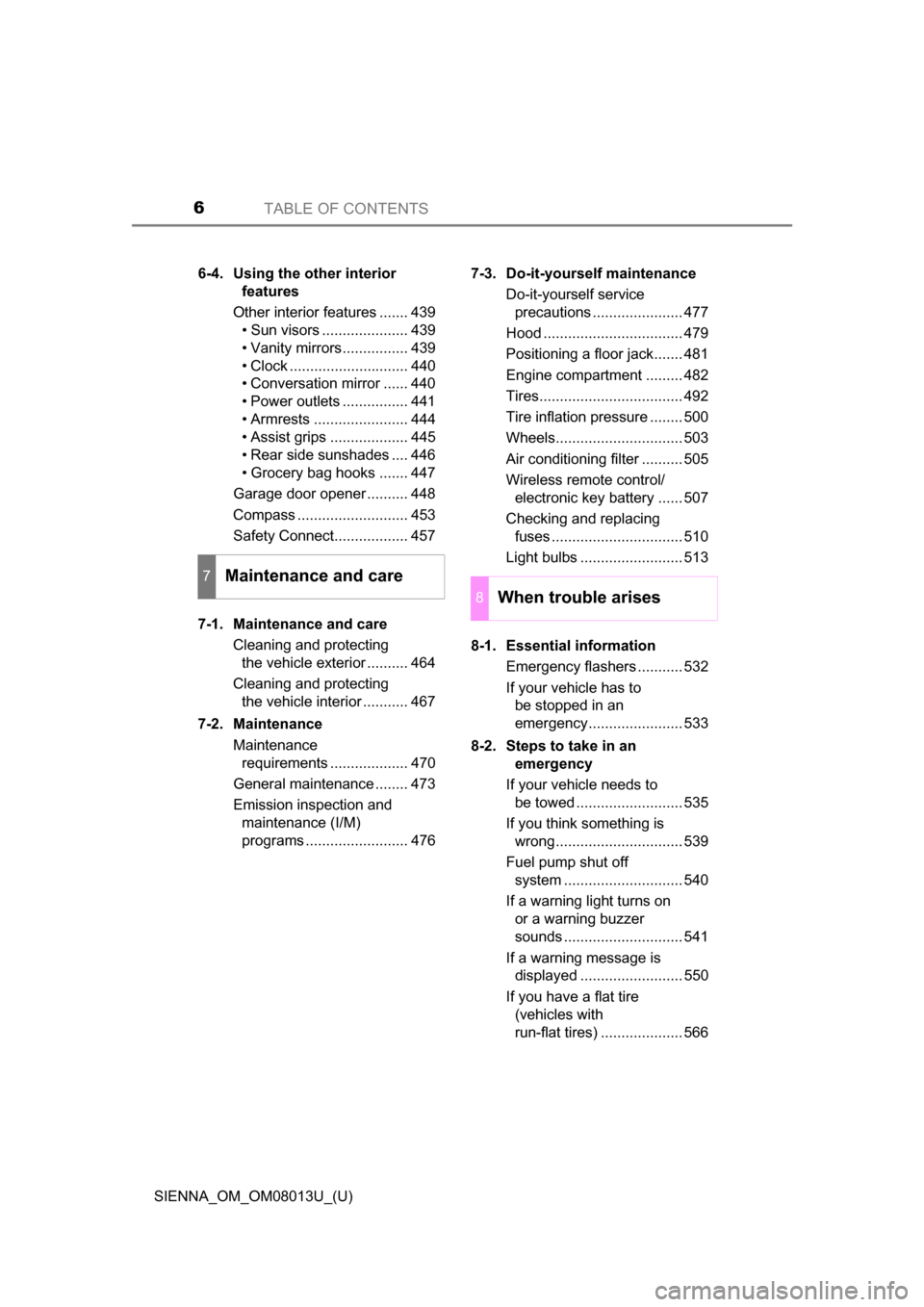
TABLE OF CONTENTS6
SIENNA_OM_OM08013U_(U)6-4. Using the other interior
features
Other interior features ....... 439 • Sun visors ..................... 439
• Vanity mirrors................ 439
• Clock ............................. 440
• Conversation mirror ...... 440
• Power outlets ................ 441
• Armrests ....................... 444
• Assist grips ................... 445
• Rear side sunshades .... 446
• Grocery bag hooks ....... 447
Garage door opener .......... 448
Compass ........................... 453
Safety Connect.................. 457
7-1. Maintenance and care Cleaning and protecting the vehicle exterior .......... 464
Cleaning and protecting the vehicle interior ........... 467
7-2. Maintenance Maintenance requirements ................... 470
General maintenance ........ 473
Emission inspection and maintenance (I/M)
programs ......................... 476 7-3. Do-it-yourself maintenance
Do-it-yourself service precautions ...................... 477
Hood .................................. 479
Positioning a floor jack....... 481
Engine compartment ......... 482
Tires................................... 492
Tire inflation pressure ........ 500
Wheels............................... 503
Air conditioning filter .......... 505
Wireless remote control/ electronic key battery ...... 507
Checking and replacing fuses ................................ 510
Light bulbs ......................... 513
8-1. Essential information Emergency flashers ........... 532
If your vehicle has to be stopped in an
emergency....................... 533
8-2. Steps to take in an emergency
If your vehicle needs to be towed .......................... 535
If you think something is wrong............................... 539
Fuel pump shut off system ............................. 540
If a warning light turns on or a warning buzzer
sounds ............................. 541
If a warning message is displayed ......................... 550
If you have a flat tire (vehicles with
run-flat tires) .................... 566
7Maintenance and care
8When trouble arises
Page 7 of 668
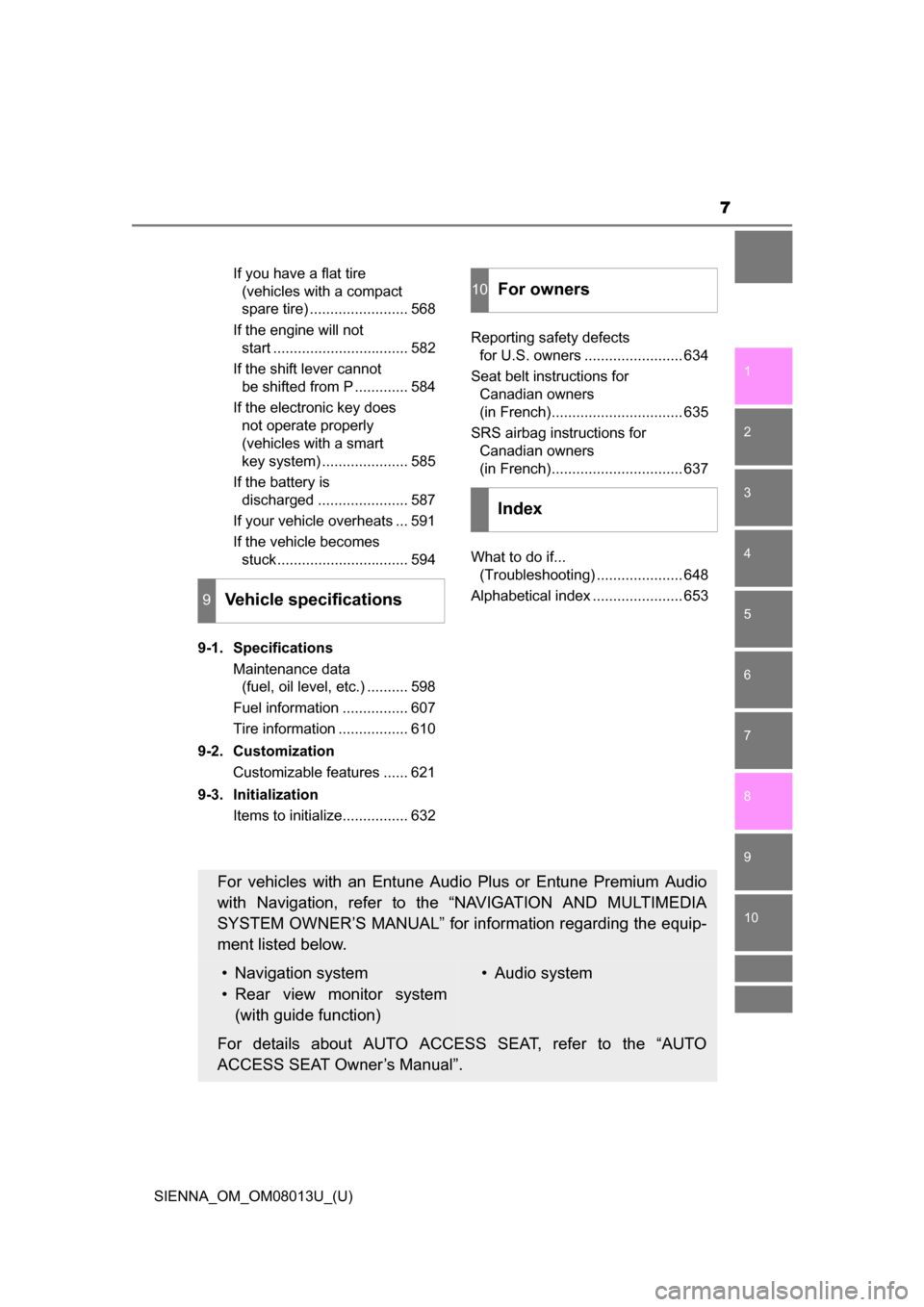
7
1
9 8
7
6 4 3
2
SIENNA_OM_OM08013U_(U)
10
5
If you have a flat tire (vehicles with a compact
spare tire) ........................ 568
If the engine will not start ................................. 582
If the shift lever cannot be shifted from P ............. 584
If the electronic key does not operate properly
(vehicles with a smart
key system) ..................... 585
If the battery is discharged ...................... 587
If your vehicle overheats ... 591
If the vehicle becomes stuck................................ 594
9-1. Specifications Maintenance data (fuel, oil level, etc.) .......... 598
Fuel information ................ 607
Tire information ................. 610
9-2. Customization Customizable features ...... 621
9-3. Initialization Items to initialize................ 632 Reporting safety defects
for U.S. owners ........................ 634
Seat belt instructions for Canadian owners
(in French)................................ 635
SRS airbag instructions for Canadian owners
(in French)................................ 637
What to do if... (Troubleshooting) ..................... 648
Alphabetical index ...................... 653
9Vehicle specifications
10For owners
Index
For vehicles with an Entune Audio Plus or Entune Premium Audio
with Navigation, refer to th e “ N AV I G AT I O N A N D M U LT I M E D I A
SYSTEM OWNER’S MANUAL” for information regarding the equip-
ment listed below.
• Navigation system
• Rear view monitor system (with guide function)• Audio system
For details about AUTO ACCESS SEAT, refer to the “AUTO
ACCESS SEAT Owner’s Manual”.
Page 15 of 668
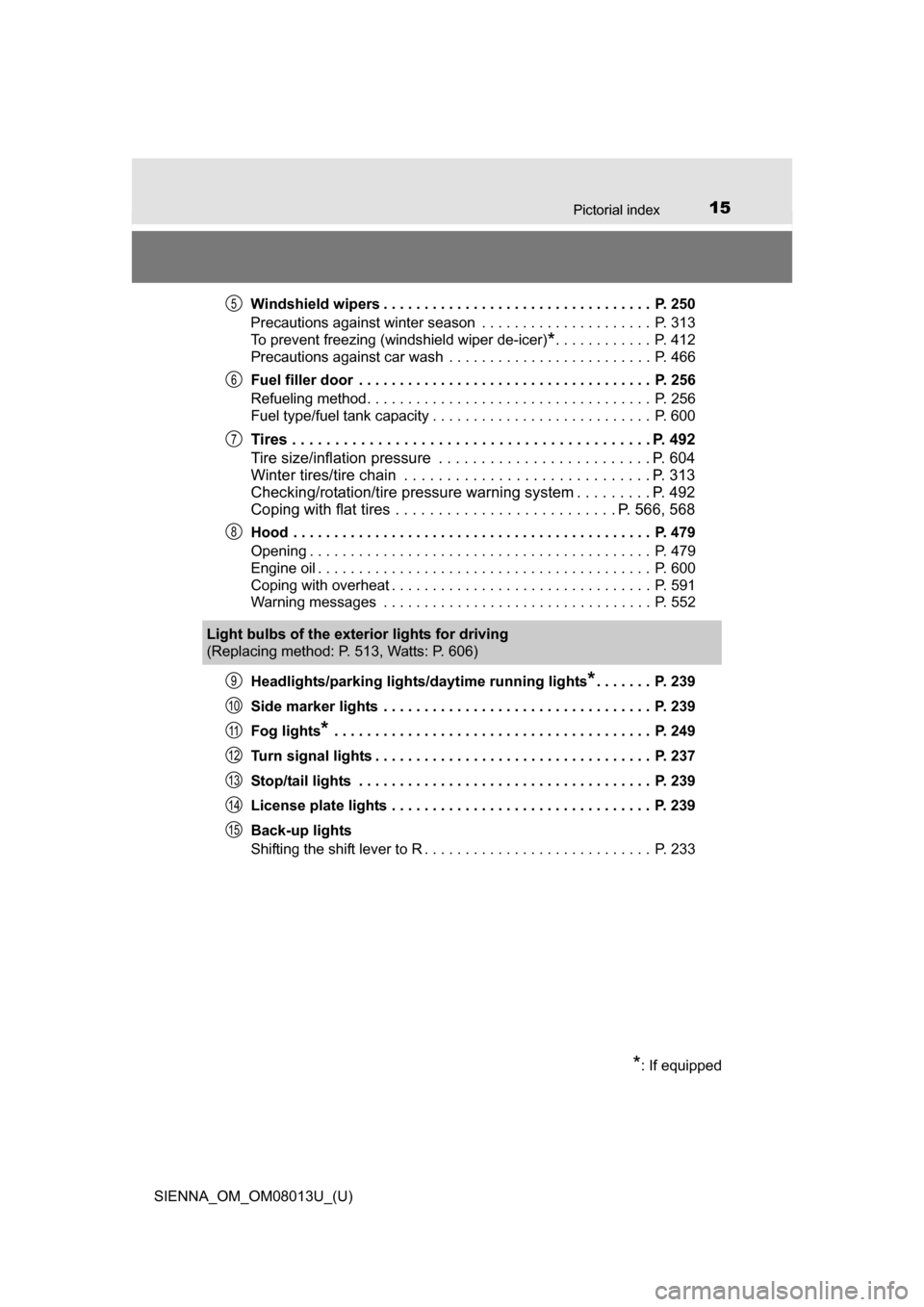
15Pictorial index
SIENNA_OM_OM08013U_(U)Windshield wipers . . . . . . . . . . . . . . . . . . . . . . . . . . . . . . . . . P. 250
Precautions against winter season . . . . . . . . . . . . . . . . . . . . . P. 313
To prevent freezing (windshield wiper de-icer)
*. . . . . . . . . . . . P. 412
Precautions against car wash . . . . . . . . . . . . . . . . . . . . . . . . . P. 466
Fuel filler door . . . . . . . . . . . . . . . . . . . . . . . . . . . . . . . . . . . . P. 256
Refueling method. . . . . . . . . . . . . . . . . . . . . . . . . . . . . . . . . . . P. 256
Fuel type/fuel tank capacity . . . . . . . . . . . . . . . . . . . . . . . . . . . P. 600
Tires . . . . . . . . . . . . . . . . . . . . . . . . . . . . . . . . . . . . . . . . . . P. 492
Tire size/inflation pressure . . . . . . . . . . . . . . . . . . . . . . . . . P. 604
Winter tires/tire chain . . . . . . . . . . . . . . . . . . . . . . . . . . . . . P. 313
Checking/rotation/tire pressure warning system . . . . . . . . . P. 492
Coping with flat tires . . . . . . . . . . . . . . . . . . . . . . . . . . P. 566, 568
Hood . . . . . . . . . . . . . . . . . . . . . . . . . . . . . . . . . . . . . . . . . . . . P. 479
Opening . . . . . . . . . . . . . . . . . . . . . . . . . . . . . . . . . . . . . . . . . . P. 479
Engine oil . . . . . . . . . . . . . . . . . . . . . . . . . . . . . . . . . . . . . . . . . P. 600
Coping with overheat . . . . . . . . . . . . . . . . . . . . . . . . . . . . . . . . P. 591
Warning messages . . . . . . . . . . . . . . . . . . . . . . . . . . . . . . . . . P. 552
Headlights/parking lights/ daytime running lights
*. . . . . . . P. 239
Side marker lights . . . . . . . . . . . . . . . . . . . . . . . . . . . . . . . . . P. 239
Fog lights
* . . . . . . . . . . . . . . . . . . . . . . . . . . . . . . . . . . . . . . . P. 249
Turn signal lights . . . . . . . . . . . . . . . . . . . . . . . . . . . . . . . . . . P. 237
Stop/tail lights . . . . . . . . . . . . . . . . . . . . . . . . . . . . . . . . . . . . P. 239
License plate lights . . . . . . . . . . . . . . . . . . . . . . . . . . . . . . . . P. 239
Back-up lights
Shifting the shift lever to R . . . . . . . . . . . . . . . . . . . . . . . . . . . . P. 233
5
6
7
8
Light bulbs of the exterior lights for driving
(Replacing method: P. 513, Watts: P. 606)
*: If equipped
9
10
11
12
13
14
15
Page 202 of 668
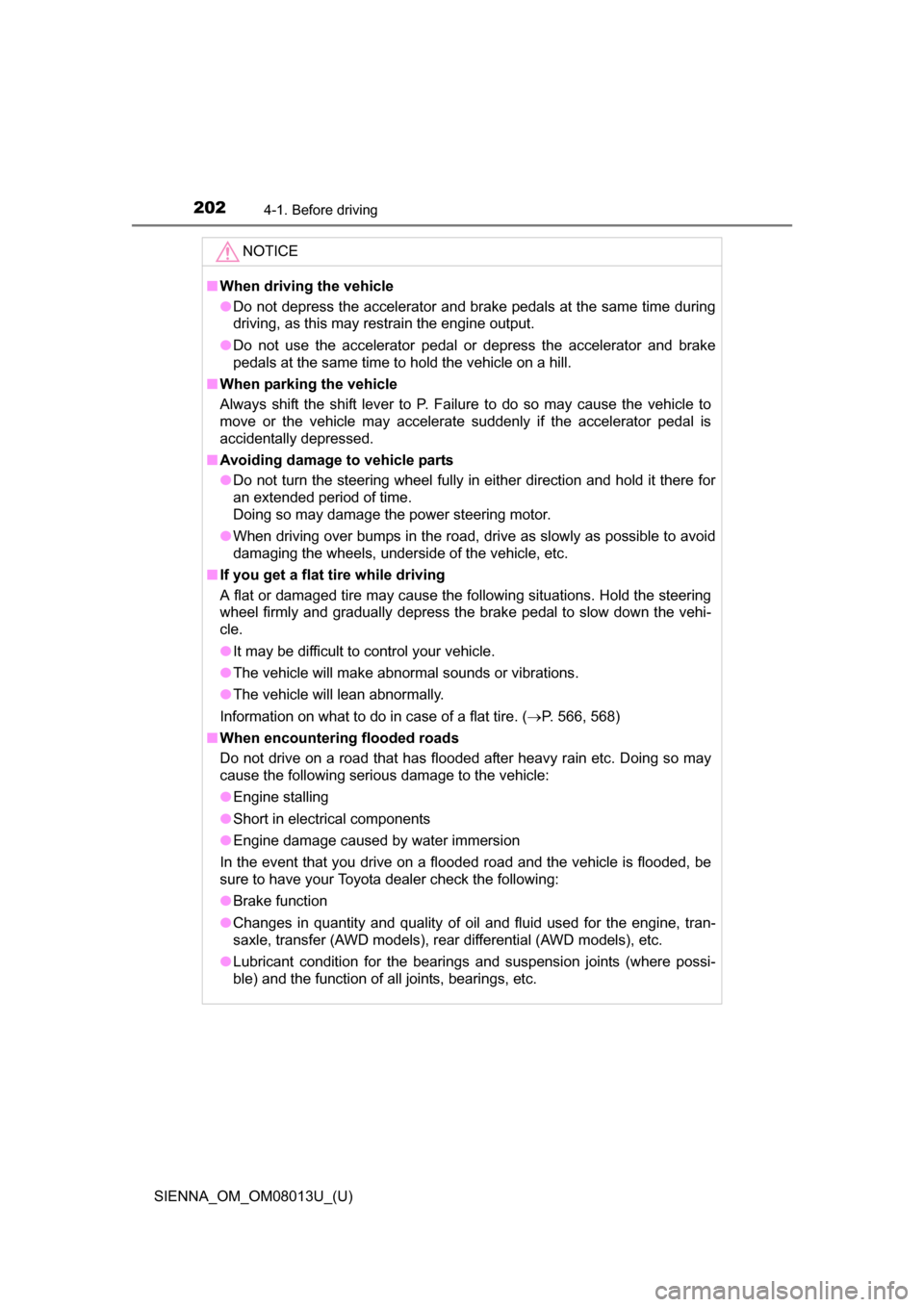
202
SIENNA_OM_OM08013U_(U)
4-1. Before driving
NOTICE
■When driving the vehicle
●Do not depress the accelerator and brake pedals at the same time during
driving, as this may restrain the engine output.
● Do not use the accelerator pedal or depress the accelerator and brake
pedals at the same time to hold the vehicle on a hill.
■ When parking the vehicle
Always shift the shift lever to P. Failure to do so may cause the vehicle to
move or the vehicle may accelerate suddenly if the accelerator pedal is
accidentally depressed.
■ Avoiding damage to vehicle parts
●Do not turn the steering wheel fully in either direction and hold it there for
an extended period of time.
Doing so may damage the power steering motor.
● When driving over bumps in the road, drive as slowly as possible to avoid
damaging the wheels, underside of the vehicle, etc.
■ If you get a flat tire while driving
A flat or damaged tire may cause the following situations. Hold the steering
wheel firmly and gradually depress the brake pedal to slow down the vehi-
cle.
●It may be difficult to control your vehicle.
● The vehicle will make abnormal sounds or vibrations.
● The vehicle will lean abnormally.
Information on what to do in case of a flat tire. ( P. 566, 568)
■ When encounterin g flooded roads
Do not drive on a road that has flooded after heavy rain etc. Doing so may
cause the following serious damage to the vehicle:
● Engine stalling
● Short in electrical components
● Engine damage caused by water immersion
In the event that you drive on a flooded road and the vehicle is flooded, be
sure to have your Toyota dealer check the following:
● Brake function
● Changes in quantity and quality of oil and fluid used for the engine, tran-
saxle, transfer (AWD models), rear differential (AWD models), etc.
● Lubricant condition for the bearings and suspension joints (where possi-
ble) and the function of all joints, bearings, etc.
Page 217 of 668
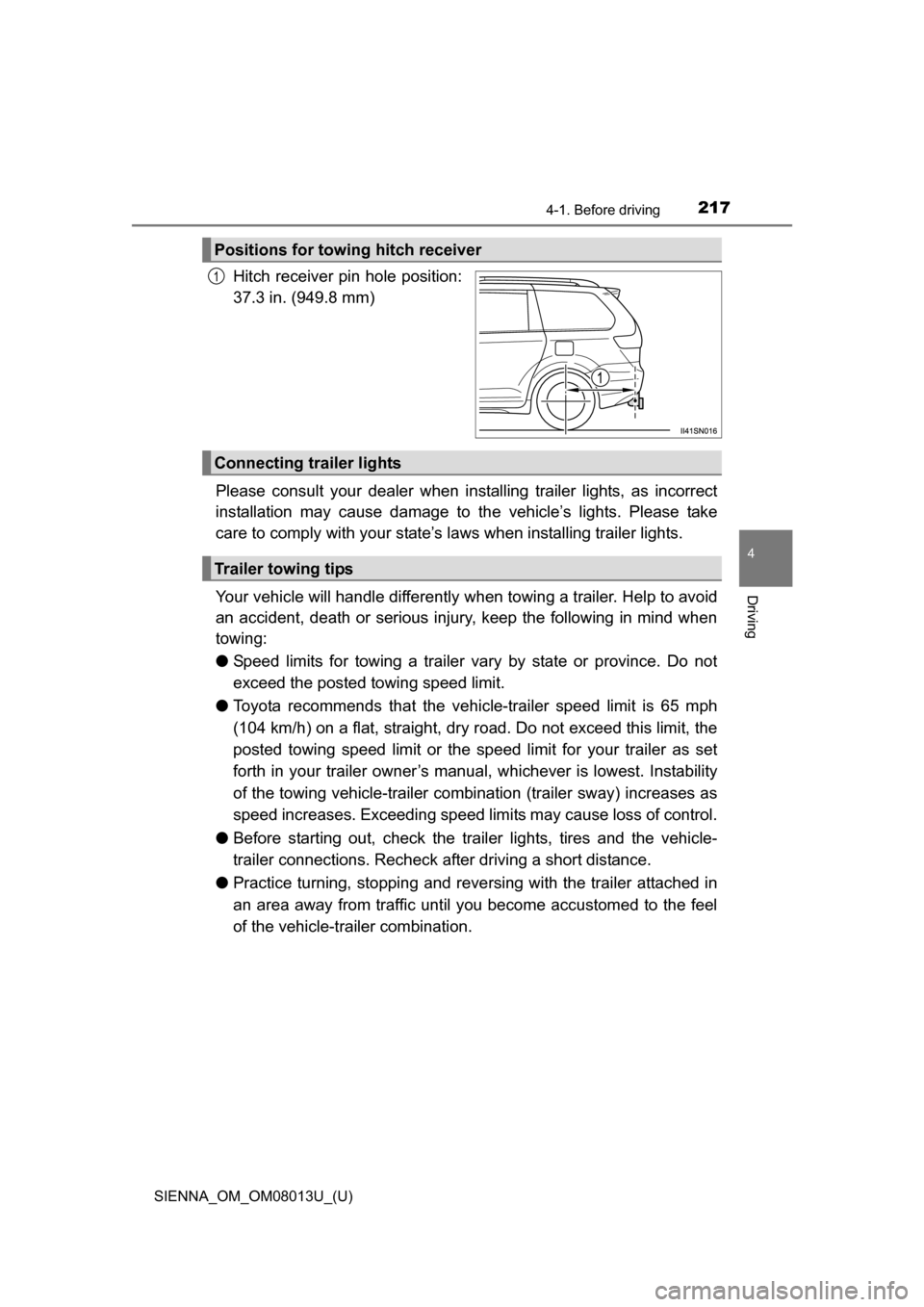
SIENNA_OM_OM08013U_(U)
2174-1. Before driving
4
Driving
Hitch receiver pin hole position:
37.3 in. (949.8 mm)
Please consult your dealer when inst alling trailer lights, as incorrect
installation may cause damage to th e vehicle’s lights. Please take
care to comply with y our state’s laws when installing trailer lights.
Your vehicle will handle differently when towing a trailer. Help to avoid
an accident, death or serious injury, keep the following in mind when
towing:
● Speed limits for towing a trailer vary by state or province. Do not
exceed the posted to wing speed limit.
● Toyota recommends that the vehicle-trailer speed limit is 65 mph
(104 km/h) on a flat, straight, dry road. Do not exceed this limit, the
posted towing speed limit or the spe ed limit for your trailer as set
forth in your trailer owner’s manual, whichever is lowest. Instability
of the towing vehicle-trailer combination (trailer sway) increases as
speed increases. Exceeding speed limits may cause loss of control.
● Before starting out, check the trailer lights, tires and the vehicle-
trailer connections. Recheck after driving a short distance.
● Practice turning, stopping and reve rsing with the trailer attached in
an area away from traffic until you become accustomed to the feel
of the vehicle-trailer combination.
Positions for towing hitch receiver
1
Connecting trailer lights
Trailer towing tips
Page 220 of 668
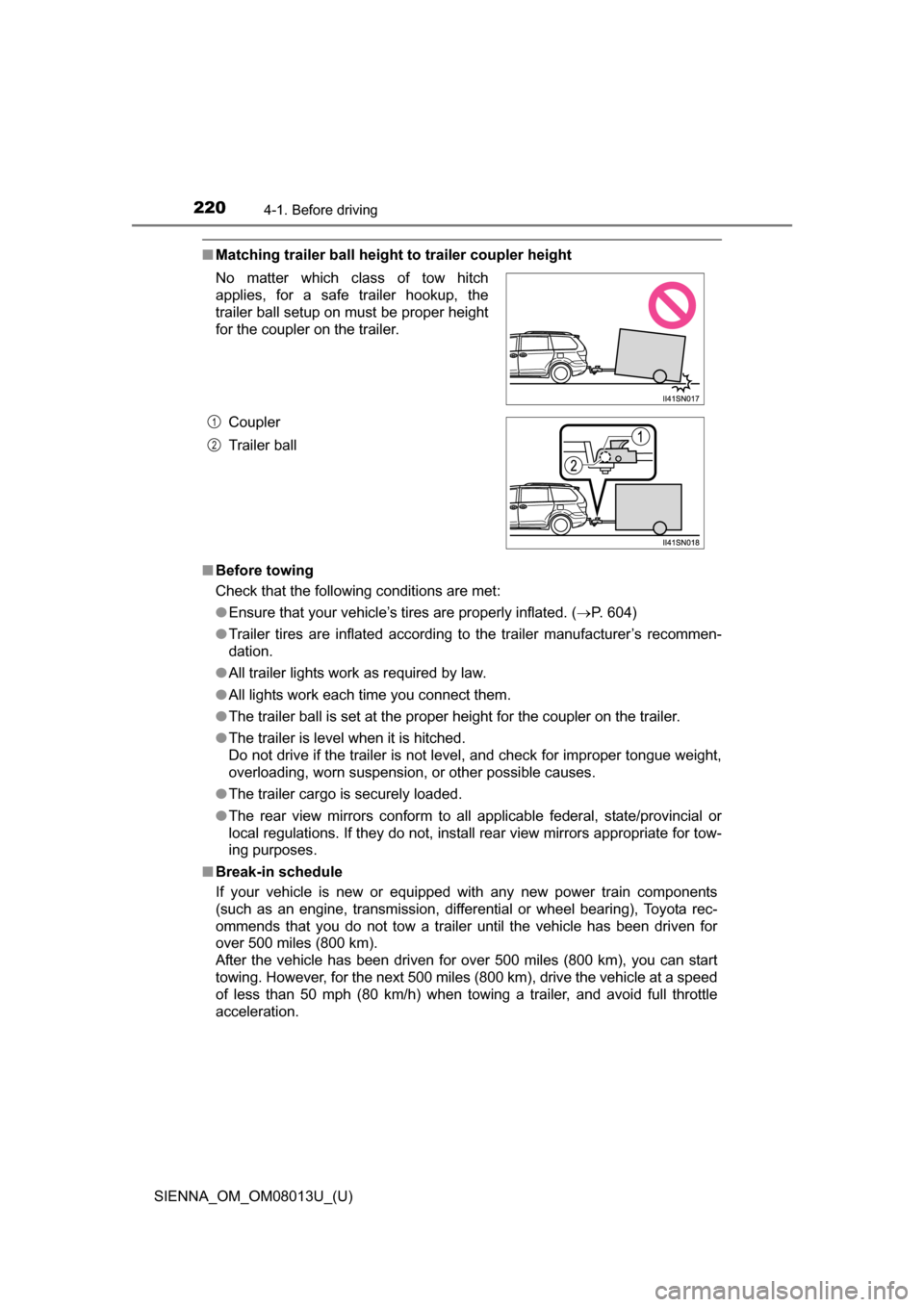
220
SIENNA_OM_OM08013U_(U)
4-1. Before driving
■Matching trailer ball height to trailer coupler height
■ Before towing
Check that the following conditions are met:
●Ensure that your vehicle’s tires are properly inflated. ( P. 604)
● Trailer tires are inflated according to the trailer manufacturer’s recommen-
dation.
● All trailer lights work as required by law.
● All lights work each time you connect them.
● The trailer ball is set at the proper height for the coupler on the trailer.
● The trailer is level when it is hitched.
Do not drive if the trailer is not level, and check for improper tongue weight,
overloading, worn suspension, or other possible causes.
● The trailer cargo is securely loaded.
● The rear view mirrors conform to all applicable federal, state/provincial or
local regulations. If they do not, install rear view mirrors appropriate for tow-
ing purposes.
■ Break-in schedule
If your vehicle is new or equipped with any new power train components
(such as an engine, transmission, differ ential or wheel bearing), Toyota rec-
ommends that you do not tow a trailer until the vehicle has been driven for
over 500 miles (800 km).
After the vehicle has been driven for over 500 miles (800 km), you can start
towing. However, for the next 500 miles (800 km), drive the vehicle at a speed
of less than 50 mph (80 km/h) when towing a trailer, and avoid full throttle
acceleration. No matter which class of tow hitch
applies, for a safe trailer hookup, the
trailer ball setup on must be proper height
for the coupler on the trailer.
Coupler
Trailer ball
1
2
Page 247 of 668
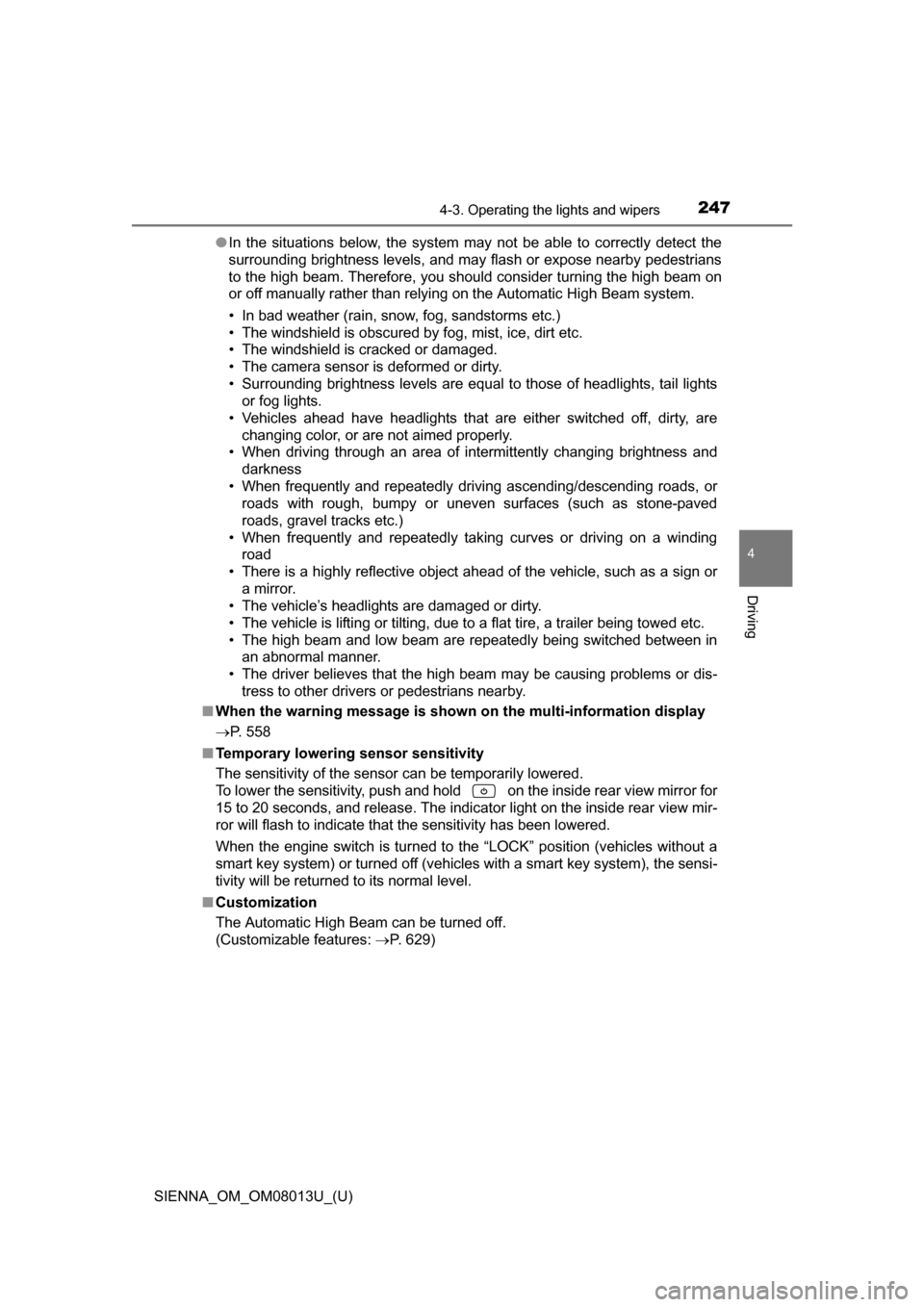
SIENNA_OM_OM08013U_(U)
2474-3. Operating the lights and wipers
4
Driving
●In the situations below, the system may not be able to correctly detect the
surrounding brightness levels, and may flash or expose nearby pedestrians
to the high beam. Therefore, you should consider turning the high beam on
or off manually rather than relying on the Automatic High Beam system.
• In bad weather (rain, snow, fog, sandstorms etc.)
• The windshield is obscured by fog, mist, ice, dirt etc.
• The windshield is cracked or damaged.
• The camera sensor is deformed or dirty.
• Surrounding brightness levels are equal to those of headlights, tail lights
or fog lights.
• Vehicles ahead have headlights that are either switched off, dirty, are changing color, or are not aimed properly.
• When driving through an area of in termittently changing brightness and
darkness
• When frequently and repeatedly driving ascending/descending roads, or roads with rough, bumpy or uneven surfaces (such as stone-paved
roads, gravel tracks etc.)
• When frequently and repeatedly taking curves or driving on a winding road
• There is a highly reflective object ahead of the vehicle, such as a sign or a mirror.
• The vehicle’s headlights are damaged or dirty.
• The vehicle is lifting or tilting, due to a flat tire, a trailer being towed etc.
• The high beam and low beam are repeatedly being switched between in an abnormal manner.
• The driver believes that the high beam may be causing problems or dis- tress to other drivers or pedestrians nearby.
■ When the warning message is shown on the multi-information display
P. 558
■ Temporary lowering sensor sensitivity
The sensitivity of the sensor can be temporarily lowered.
To lower the sensitivity, push and hold on the inside rear view mirror for
15 to 20 seconds, and release. The indicator light on the inside rear view mir-
ror will flash to indicate that the sensitivity has been lowered.
When the engine switch is turned to the “LOCK” position (vehicles without a
smart key system) or turned off (vehicles with a smart key system), the sensi-
tivity will be returned to its normal level.
■ Customization
The Automatic High Beam can be turned off.
(Customizable features: P. 629)
Page 291 of 668
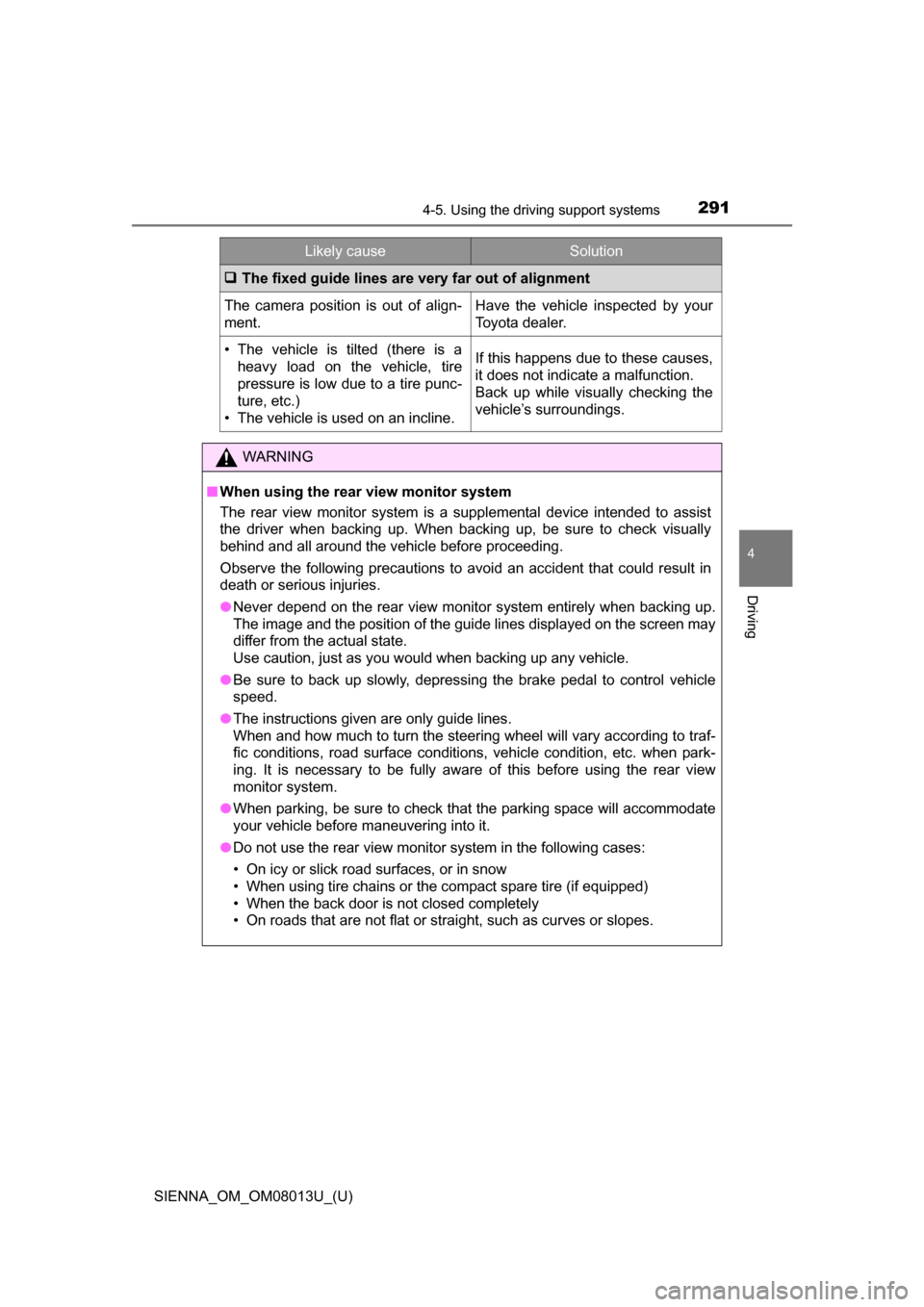
SIENNA_OM_OM08013U_(U)
2914-5. Using the driving support systems
4
Driving
The fixed guide lines are very far out of alignment
The camera position is out of align-
ment.Have the vehicle inspected by your
Toyota dealer.
• The vehicle is tilted (there is a
heavy load on the vehicle, tire
pressure is low due to a tire punc-
ture, etc.)
• The vehicle is used on an incline.If this happens due to these causes,
it does not indicate a malfunction.
Back up while visually checking the
vehicle’s surroundings.
WARNING
■ When using the rear view monitor system
The rear view monitor system is a supplemental device intended to assist
the driver when backing up. When backing up, be sure to check visually
behind and all around the vehicle before proceeding.
Observe the following precautions to avoid an accident that could result in
death or serious injuries.
● Never depend on the rear view monitor system entirely when backing up.
The image and the position of the guide lines displayed on the screen may
differ from the actual state.
Use caution, just as you would when backing up any vehicle.
● Be sure to back up slowly, depressing the brake pedal to control vehicle
speed.
● The instructions given are only guide lines.
When and how much to turn the steering wheel will vary according to traf-
fic conditions, road surface conditions, vehicle condition, etc. when park-
ing. It is necessary to be fully aware of this before using the rear view
monitor system.
● When parking, be sure to check that the parking space will accommodate
your vehicle before maneuvering into it.
● Do not use the rear view monitor system in the following cases:
• On icy or slick road surfaces, or in snow
• When using tire chains or the compact spare tire (if equipped)
• When the back door is not closed completely
• On roads that are not flat or straight, such as curves or slopes.
Likely causeSolution